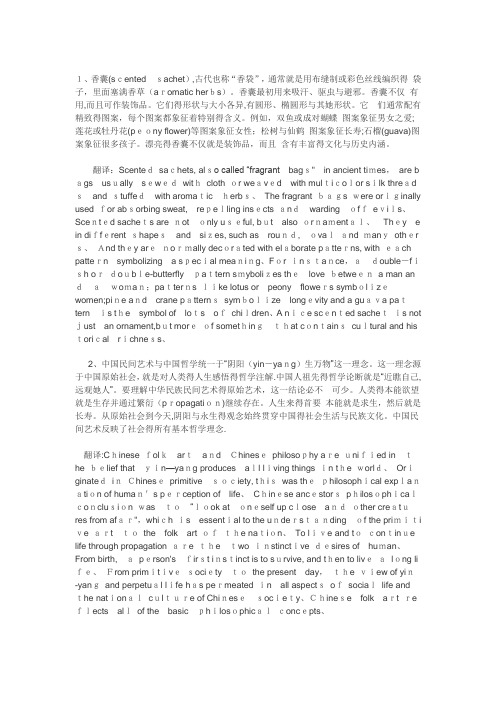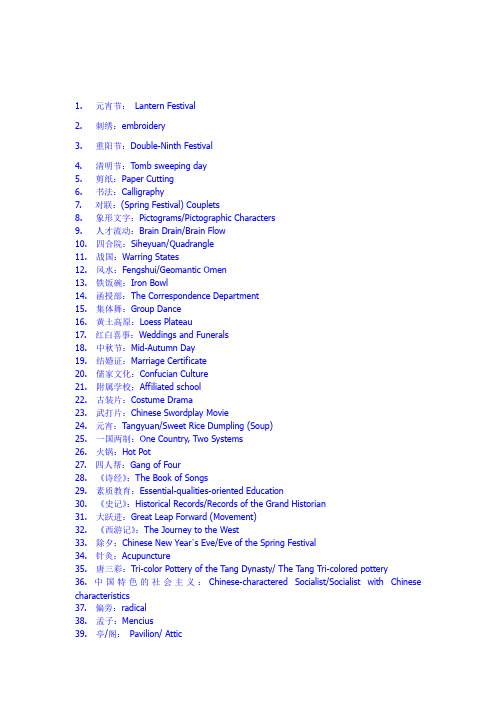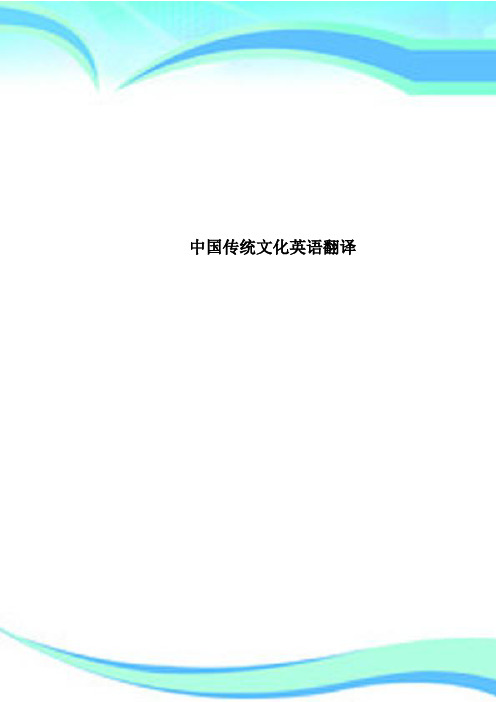传统文化翻译
中国传统文化英语翻译

1、香囊(scentedsachet),古代也称“香袋”,通常就是用布缝制或彩色丝线编织得袋子,里面塞满香草(aromatic herbs)。
香囊最初用来吸汗、驱虫与避邪。
香囊不仅有用,而且可作装饰品。
它们得形状与大小各异,有圆形、椭圆形与其她形状。
它们通常配有精致得图案,每个图案都象征着特别得含义。
例如,双鱼或成对蝴蝶图案象征男女之爱;莲花或牡丹花(peony flower)等图案象征女性;松树与仙鹤图案象征长寿;石榴(guava)图案象征很多孩子。
漂亮得香囊不仅就是装饰品,而且含有丰富得文化与历史内涵。
翻译:Scentedsachets, also called “fragrant bags"in ancient times,are b ags usually sewedwithcloth or weaved with multicolor silk thread sand stuffedwith aromaticherbs、The fragrant bags were originally used for absorbing sweat,repelling insects andwardingoffevils、Scented sachets are notonly useful, but also ornamental、They e in different shapesand sizes, such as round,ovaland manyother s、And they arenormally decorated with elaborate patterns, with each pattern symbolizing a special meaning、For instance,adouble-fish ordouble-butterflypattern smybolizes thelove betweena man an dawoman;patterns like lotus or peony flowers symbolizewomen;pine and crane patternssymbolize longevity and a guava patternis the symbol of lots ofchildren、A nice scented sachetis not just an ornament,but moreof somethingthat containscultural and his torical richness、2、中国民间艺术与中国哲学统一于“阴阳(yin-yang)生万物”这一理念。
《传统文化翻译》课程教学大纲

《传统文化翻译》课程教学大纲(英文名称:Translation of Traditional Chinese Cultural Classics)一、课程说明1、课程编码:05510133012、学分:2 学时:363、课程类别:专业选修课4、开课学院:翻译学院5、课程简介:《传统文化翻译》是全日制翻译硕士专业学位(MTI)课程中的一门专业选修课。
该课程旨在指导学生在具备较为扎实的汉英翻译理论素养与实践能力的基础上,进行系统的中国传统文化典籍文本汉英翻译实践训练,培养学生中国传统文化典籍文本汉英翻译实践能力,并培养学生结合相关理论对中国传统文化典籍汉英翻译实践中的问题展开分析与研讨的意识与能力。
6、预备知识:本课程的先行课程主要包括《翻译概论》、《中国语言文化》、《基础笔译》、《英汉对比与翻译》等,学生须具备较为深厚的中国传统文化素养、较为全面的翻译理论基础、较为扎实的文言功底和较为熟练的汉英翻译实践能力。
7、教学目的与要求:本课程旨在紧跟时代发展脉搏,弘扬国学精神,传播中华文化,研读国学经典,探究中国文化典籍文本汉英翻译实践策略与技巧,提升翻译硕士人才综合人文素养与实践能力。
本课程以翻译学、语言学与文化学为基本理论架构和方法导引,立足翻译实践的过程训练,适当引导学生进行理性思辨,进行案例分析和理论探究,为学生将来从事翻译及相关事业奠定良好的理论素养基础,培养扎实的翻译实践能力。
8、考核方法与要求:考核方法:考查组成及占分比例:日常表现40%;课程论文占60%。
9、教材与参考书:教材:无参考书目:《中国文化典籍英译》,王宏印,外语教学与研究出版社(第1版),2009年。
《典籍英译研究》,李正拴、汪榕培,河北大学出版社,2005年。
《新编英汉对比与翻译》,刘宓庆,中国对外翻译出版社,2006年。
《高级英汉翻译理论与实践》,叶子南,清华大学出版社,2008年。
《中国哲学史》,冯友兰,商务印书馆,2011年。
chinese tradition中国传统文化知识翻译

1.元宵节:Lantern Festival2. 刺绣:embroidery3. 重阳节:Double-Ninth Festival4. 清明节:Tomb sweeping day5. 剪纸:Paper Cutting6. 书法:Calligraphy7. 对联:(Spring Festival) Couplets2.8. 象形文字:Pictograms/Pictographic Characters 9. 人才流动:Brain Drain/Brain Flow 四合院:Siheyuan/Quadrangle 11. 战国:Warring States 12. 风水:Fengshui/Geomantic Omen3.13. 铁饭碗:Iron Bowl4.14. 函授部:The Correspondence Department 15. 集体舞:Group Dance 16. 黄土高原:Loess Plateau 17. 红白喜事:Weddings and Funerals 18. 中秋节:Mid-Autumn Day5.19. 结婚证:Marriage Certificate20. 儒家文化:Confucian Culture 21. 附属学校:Affiliated school 22. 古装片:Costume Drama 23. 武打片:Chinese Swordplay Movie 24. 元宵:Tangyuan/Sweet Rice Dumpling (Soup) 25. 一国两制:One Country, Two Systems6.26. 火锅:Hot Pot 27. 四人帮:Gang of Four 28. 《诗经》:The Book of Songs 29. 素质教育:Essential-qualities-oriented Education 30. 《史记》:Historical Records/Records of the Grand Historian 37.1. 大跃进:Great Leap Forward (Movement) 32. 《西游记》:The Journey to the West 33. 除夕:Chinese New Year’s Eve/Eve of the Spring Festival8.34. 针灸:Acupuncture 35. 唐三彩:Tri-color Pottery of the Tang Dynasty/ The Tang Tri-colored pottery9.36. 中国特色的社会主义:Chinese-charactered Socialist/Socialist with Chinese characteristics 37. 偏旁:radical 38. 孟子:Mencius10.39. 亭/阁:Pavilion/ Attic 40. 大中型国有企业:Large and Medium-sized State-owned Enterprises 41. 火药:gunpowder 42. 农历:Lunar Calendar11.43. 印/玺:Seal/Stamp 44. 物质精神文明建设:The Construction of Material Civilization and Spiritual Civilization 45. 京剧:Beijing Opera/Peking Opera12.46. 秦腔:Crying of Qin People/Qin Opera 47. 太极拳:Tai Chi 48. 独生子女证:The Certificate of One-child13.49. 天坛:Altar of Heaven in Beijing 50. 小吃摊:Snack Bar/Snack Stand 51. 红双喜:Double Happiness 52. 政治辅导员:Political Counselor/School Counselor14.53. 春卷:Spring Roll(s) 54. 莲藕:Lotus Root 55. 追星族:Star Struck 56. 故宫博物院:The Palace Museum 57. 相声:Cross-talk/Comic Dialogue 58. 下岗:Lay off/Laid off 59. 北京烤鸭:Beijing Roast Duck15.60. 高等自学考试:Self-taught Examination of Higher Education 61. 烟花爆竹:fireworks and firecracker 62. 敦煌莫高窟:Mogao Caves16.63. 电视小品:TV Sketch/TV Skit 64. 香港澳门同胞:Compatriots from Hong Kong and Macao 65. 文化大革命:Cultural Revolution17.66. 长江中下游地区:The Mid-low Reaches of Yangtze River 67. 门当户对:Perfect Match/Exact Match 68. 《水浒》:Water Margin/Outlaws of the Marsh18.69. 中外合资企业:Joint Ventures 70. 文房四宝(笔墨纸砚):"The Four Treasure of the Study" "Brush, Inkstick, Paper, and Inkstone"19.71.兵马俑:cotta Warriors/ Terracotta Army 72.旗袍:cheongsam。
人教版六年级中华优秀传统文化原文及翻译

五单元共赢17 同甘苦共患难48出自:《诗经·秦风·无衣》全文:岂曰无衣?与子同袍。
王于兴师,修我戈矛。
与子同仇。
岂曰无衣?与子同泽。
王于兴师,修我矛戟。
与子偕作。
岂曰无衣?与子同裳。
王于兴师,修我甲兵。
与子偕行。
直译:谁说我们没衣穿?与你同穿那长袍。
君王发兵去交战,修整我那戈与矛,杀敌与你同目标。
谁说我们没衣穿?与你同穿那内衣。
君王发兵去交战,修整我那矛与戟,出发与你在一起。
谁说我们没衣穿?与你同穿那战裙。
君王发兵去交战,修整甲胄与刀兵,杀敌与你共前进。
扩展资料:《秦风·无衣》是《诗经》中最著名的爱国主义诗篇。
故事背景产生于秦地人民抗击西戎入侵者的军中战歌。
在这反侵略的战争中,秦国民众表现了英勇无畏的尚武精神,同时亦创造了这首充满爱国主义激情的慷慨战歌。
“谁说我们贫穷,我们跟你一样也有战袍。
就要出兵打仗了,我们已磨好了戈矛,君王啊,我们与您同仇敌忾,共同抗敌!”点睛战士们从穿衣到作战始终患难与共。
这种携手并肩同舟共济的协作精神是成就自身取得成功的关键。
正如国语所说,;同德则同心同心则同志。
50八家为邻,家得百亩,余夫各得二十五亩,家为公田十亩,余二十亩共为庐舍,各得二亩半。
八家相保,出入更守,疾病相忧,患难相救,有无相贷,饮食相召,嫁娶相谋,渔猎分得,仁恩施行,是以其民和亲而相好。
诗曰:“中田有庐,疆场有瓜。
18 识大体顾大局51子贡曰:“管仲非仁者与?桓公杀公子纠,不能死,又相之。
”子曰:“管仲相桓公,霸诸侯,一匡天下,民到于今受其赐。
微管仲,吾其被发左衽矣。
岂若匹夫匹妇之为谅也,自经于沟渎而莫之知也!”译文子贡说:“管仲不是仁人吧?桓公杀了公子纠,[管仲]没自杀,却又做了桓公的相。
”孔子说:“管仲辅佐桓公,[使齐国]在诸侯中称霸,匡正了天下,人民到如今还受到他给的好处。
如果没有管仲,我们恐怕已经沦为披头散发衣襟在左边开的落后民族了。
难道[管仲]像一般的平庸男女那样,为了守小节,在小山沟里上吊自杀,而不被人所知道吗?”点睛管仲辅佐齐桓公,九合诸侯,一匡天下,是老百姓受到了恩惠,所以孔子赞美他是仁者。
中国传统文化词汇、诗词翻译

一.中国古代传统文化翻译1. 传统词汇刺绣:embroidery剪纸:Paper Cutting书法:Calligraphy对联:(Spring Festival) Couplets象形文字:Pictograms/Pictographic Characters人才流动:Brain Drain/Brain Flow四合院:Siheyuan/Quadrangle战国:Warring States风水:Fengshui/Geomantic Omen铁饭碗:Iron Bowl /well-paid job集体舞:Group Dance红白喜事:Weddings and Funerals中秋节:Mid-Autumn Day结婚证:Marriage Certificate儒家文化:Confucian Culture附属学校:Affiliated school元宵:Tangyuan/Sweet Rice Dumpling一国两制:One Country, Two Systems火锅:Hot Pot《诗经》:The Book of Songs素质教育:Essential-qualities-oriented Education《史记》:Historical Records/Records of the Grand Historian大跃进:Great Leap Forward (Movement)除夕:Chinese New Year’s Eve/Eve of the Spring Festival中国特色的社会主义:Chinese-charactered Socialist/Socialist with Chinese characteristics孟子:Mencius亭/阁: Pavilion/ Attic大中型国有企业:Large and Medium-sized State-owned Enterprises火药:gunpowder农历:Lunar Calendar京剧:Beijing Opera/Peking Opera太极拳:Tai Chi独生子女证:The Certificate of One-child天坛:Altar of Heaven in Beijing小吃摊:Snack Bar/Snack Stand春卷:Spring Roll(s)追星族:Star Struck故宫博物院:The Palace Museum相声:Cross-talk/Comic Dialogue下岗:Lay off/Laid off北京烤鸭:Beijing Roast Duck烟花爆竹:fireworks and firecracker电视小品:TV Sketch/TV Skit香港澳门同胞:Compatriots from Hong Kong and Macao文化大革命:Cultural Revolution门当户对:Perfect Match/Exact Match中外合资企业:Joint Ventures文房四宝(笔墨纸砚):"The Four Treasure of the Study" "Brush, Inkstick, Paper, and Inkstone"四大名著the Four Great Classical Novels《三国演义》The Romance of the Three Kingdoms 《水浒传》Heroes of the Marshes ; Water Margins 《西游记》Pilgrimage to the West 《红楼梦》Dream of the Red Mansions ; The story of the Stone2.中国意念词八卦trigram阴、阳 yin, yang道 Dao江湖(世界) the jianghu World (the traits’ world)e.g. You can’t control everything in a traits’ world. (人在江湖,身不由己)道 Daoism(Taoism)上火 excessive internal heat儒学 Confucianism红学(《红楼梦》研究) redology世外桃源 Shangri-la or Arcadia大锅饭 getting an equal share regardless of the work done不搞一刀切 no imposing uniformity on …合乎国情,顺乎民意 to conform with the national conditions and the will of the people脱贫 to shake off poverty; anti-poverty3.中华民族的喜庆节日国庆节 National Day中秋节 Mia-Autumn Festival春节 Spring Festival元宵节 Lantern Festival儿童节 Children’s Day端午节 Dragon Boat Festival妇女节 Women’s Day泼水节 Water-Splashing Day五四青年节 Youth Day重阳节:Double-Ninth Festival清明节:Tomb sweeping day4.中国独特的传统饮食馄饨 wonton花卷 steamed twisted rolls套餐 set meal盒饭 box lunch; Chinese take-away米豆腐 rice tofu米粉 rice noodles冰糖葫芦 a stick of sugar-coated haws (or apples,etc.) 粉丝 glass noodles豆腐脑 jellied bean curd5.中国新兴事物中国电信 China Telecom中国移动 China Mobile中国电脑联网 Chinanet三峡工程 the Three Gorges Project 希望工程 Project Hope扶贫工程 Anti-Poverty Project菜篮子工程 Vegetable Basket Project 温饱工程 Decent-Life Project安居工程 Economy Housing Project西部大开发 Go-West Campaign6.特有的一些汉语词汇噱头;掉包袱 gimmick, stunt夜猫子 night people; night-owls本命年 this animal year of sb.处世之道 philosophy of life姻缘 yinyuan(prefixed fate of marriage)7.具有文化特色的现代表述大陆中国 Mainland China红色中国 socialist China四化 Four Modernizations终生职业 job-for-life铁饭碗 iron rice bowl大锅饭 communal pot关系户 closely-related units外出打工人员 migrant workers关系网 personal nets, closely-knitted guild五讲(讲文明、讲礼貌、讲卫生、讲秩序、讲道德):the Five Merits focus on decorum, manners, hygiene, disciplines and morals四美(心灵美、语言美、行为美、环境美): the Four Virtues are golden heart, refined language, civilized behavior, and green environment8.中国古代独特事物宣纸 rice paper衙门 yamen叩头 kowtow孔子Confucius武术 wushu(Chinese Martial Arts)功夫 kungfu ;kung fu中庸 the way of medium (cf. Golden Means)中和 harmony (zhonghe)孝顺 to show filial obedience孝子 dutiful son家长 family head三纲:君为臣纲,父为子纲,夫为妻纲 three cardinal guides: ruler guides subject, father guides son husband guides wife五常:仁、义、理、智、信 five constant virtues: benevolence (humanity), righteousness, propriety, wisdom and fidelity多子多福:The more sons/children, the more blessing/ great happiness 养儿防老:raising sons to support one in one’s old age9.近一季度见诸报端的中国现代特色词汇翻译基层监督 grass-roots supervision婚介所 matrimonial agency婚外恋 extramarital love婚纱摄影 bride photo黑心棉 shoddy cotton机器阅卷 machine scoring集中精力把经济建设搞上去 go all out for economic development加强舆论监督 ensure the correct orientation is maintained in public opinion假帐 accounting fraud叫板 challenge; pick a quarrel矫情 use lame arguments借调 temporarily transfer渐进式台独 gradual Taiwan independence扩大中等收入者比重 Raise the proportion of the middle-income group. 扩大内需,刺激消费expand domestic demand and consumption安居工程 housing project for low-income urban residents 智力密集型 concentration of brain power; knowledge-intensive外资企业 overseas-funded enterprises下岗职工 laid-off workers分流 reposition of redundant personnel三角债 chain debts素质教育 education for all-round development豆腐渣工程 jerry-built projects社会治安情况 law-and-order situation民族国家 nation state西部大开发 Development of the West Regions可持续性发展 sustainable development风险投资 risk investment通货紧缩 deflation扩大内需 to expand domestic demand计算机辅助教学 computer-assisted instruction ( CAI ) 网络空间 cyberspace虚拟现实 virtual reality网民 netizen ( net citizen )电脑犯罪 computer crime电子商务 the e-business网上购物 shopping online应试教育 exam-oriented education学生减负 to reduce study load总裁助理assistant president综合治理comprehensive treatment安居工程housing project for low-income urban residents信息化information-based; informationization智力密集型concentration of brain power; knowledge-intensive外资企业overseas-funded enterprises下岗职工laid-off workers分流reposition of redundant personnel素质教育education for all-round development通货紧缩deflation扩大内需to expand domestic demand计算机辅助教学computer-assisted instruction ( CAI )下海plunge into the commercial sea下网off line小康之家well-off family; comfortably-off family新秀up-and-coming star, rising star新新人类New Human Being ; X Generation形象小姐image representative of a product or a brand虚拟网virtual net学生处students" affairs division研究生毕业证/学位证graduate diploma/graudate degree"sdiploma摇钱树cash cow以人为本people oriented; people foremost义务教育compulsory education易拉罐pop can应试教育examination-oriented education system舆论导向direction of public opinion运球dribble在职博士生on-job doctorate早恋puppy love招生就业指导办公室enrolment and vocation guidance office 证券营业部stock exchange; security exchange知识产权intellectual property rights中专生secondary specialized or technical school student 中流砥柱mainstay, chief corner stone专卖店exclusive agency; franchised store自我保护意识self-protection awareness综合国力comprehensive national strength综合业务数字网integrated service digital network (ISDN) 公正、公平、公开just, fair and open好莱坞大片Hollywood blockbuster黄金时段prime time假唱lip-synch劲射power shot拉拉队cheering squad来电显示电话机caller ID telephone论文答辩(thesis) oral defense泡沫经济bubble economy票贩子scalper, ticket tout拳头产品competitive products; knock-out products;blockbuster三角恋爱love triangle三维动画片three-dimensional animation"扫黄"/"打非" eliminate pornography and illegal publications申办奥运会bid for the Olympic Games实现中华民伟大复兴bring about a great rejuvenation of the Chinese nation市场疲软sluggish market素质教育education for all-around development筒子楼:tube-shaped apartment脱贫致富cast (shake, throw) off poverty and set out on a road to prosperity网吧Internet bar网恋online love affair网上冲浪surf the Internet网上交易平台online trading platform无人售票self-service ticketing二.中国古代特色产品介绍1.酒是中国人生活中的重要饮料之一。
【优质】中国古代传统文化翻译-中国特色词汇英语翻译

中国古代传统文化翻译-中国特色词汇英语翻译(黄色背景的建议记忆,其他了解)1. 元宵节:Lantern Festival2. 刺绣:embroidery3. 重阳节:Double-Ninth Festival4. 清明节:Tomb sweeping day5. 剪纸:Paper Cutting6. 书法:Calligraphy7. 对联:(Spring Festival) Couplets8. 象形文字:Pictograms/Pictographic Characters9. 人才流动:Brain Drain/Brain Flow10. 四合院:Siheyuan/Quadrangle11. 战国:Warring States12. 风水:Fengshui/Geomantic Omen13. 铁饭碗:Iron Bowl14. 函授部:The Correspondence Department15. 集体舞:Group Dance16. 黄土高原:Loess Plateau17. 红白喜事:Weddings and Funerals18. 中秋节:Mid-Autumn Day19. 结婚证:Marriage Certificate20. 儒家文化:Confucian Culture21. 附属学校:Affiliated school22. 古装片:Costume Drama23. 武打片:Chinese Swordplay Movie24. 元宵:Tangyuan/Sweet Rice Dumpling25. 一国两制:One Country, Two Systems26. 火锅:Hot Pot27. 四人帮:Gang of Four28. 《诗经》:The Book of Songs29. 素质教育:Essential-qualities-oriented Education30. 《史记》:Historical Records/Records of the Grand Historian31. 大跃进:Great Leap Forward (Movement)32. 《西游记》:The Journey to the West33. 除夕:Chinese New Year’s Eve/Eve of the Spring Festival34. 针灸:Acupuncture35. 唐三彩:Tri-color Pottery of the Tang Dynasty/ The Tang Tri-colored pottery36. 中国特色的社会主义:Chinese-charactered Socialist/Socialist with Chinese characteristics37. 偏旁:radical38. 孟子:Mencius39. 亭/阁:Pavilion/ Attic40. 大中型国有企业:Large and Medium-sized State-owned Enterprises41. 火药:gunpowder42. 农历:Lunar Calendar43. 印/玺:Seal/Stamp44. 物质精神文明建设:The Construction of Material Civilization and Spiritual Civilization45. 京剧:Beijing Opera/Peking Opera46. 秦腔:Crying of Qin People/Qin Opera47. 太极拳:Tai Chi48. 独生子女证:The Certificate of One-child49. 天坛:Altar of Heaven in Beijing50. 小吃摊:Snack Bar/Snack Stand51. 红双喜:Double Happiness52. 政治辅导员:Political Counselor/School Counselor53. 春卷:Spring Roll(s)54. 莲藕:Lotus Root55. 追星族:Star Struck56. 故宫博物院:The Palace Museum57. 相声:Cross-talk/Comic Dialogue58. 下岗:Lay off/Laid off59. 北京烤鸭:Beijing Roast Duck60. 高等自学考试:Self-taught Examination of Higher Education61. 烟花爆竹:fireworks and firecracker62. 敦煌莫高窟:Mogao Caves63. 电视小品:TV Sketch/TV Skit64. 香港澳门同胞:Compatriots from Hong Kong and Macao65. 文化大革命:Cultural Revolution66. 长江中下游地区:The Mid-low Reaches of Yangtze River67. 门当户对:Perfect Match/Exact Match68. 《水浒》:Water Margin/Outlaws of the Marsh69. 中外合资企业:Joint Ventures70. 文房四宝(笔墨纸砚):"The Four Treasure of the Study" "Brush, Inkstick, Paper, and Inkstone"1、中国意念词(Chinesenesses)八卦trigram阴、阳yin, yang道Dao(cf. logo)江湖(世界)the jianghu World (the traits’world)e.g. You can’t control everything in a traits’world. (人在江湖,身不由己)道Daoism(Taoism)上火excessive internal heat儒学Confucianism红学(《红楼梦》研究)redology世外桃源Shangri-la or Arcadia开放kaifang (Chinese openness to the outside world)大锅饭getting an equal share regardless of the work done伤痕文学scar literature or the literature of the wounded不搞一刀切no imposing uniformity on …合乎国情,顺乎民意to conform with the national conditions and the will of the people 乱摊派,乱收费imposition of arbitrary quotas and service charge铁交椅iron (lifetime) post’s; guaranteed leading post脱贫to shake off poverty; anti-poverty治则兴,乱则衰Order leads to prosperity and chaos to decline2 、中华民族的喜庆节日(Chinese Festivial)国庆节National Day中秋节Mia-Autumn Festival春节Spring Festival元宵节Lantern Festival儿童节Children’s Day端午节Dragon Boat Festival妇女节Women’s Day泼水节Water-Splashing Day五四青年节Youth Day3、中国独特的传统饮食(Unique Traditional Chinese Foods)馄饨wonton花卷steamed twisted rolls套餐set meal盒饭box lunch; Chinese take-away米豆腐rice tofu魔芋豆腐konjak tofu米粉rice noodles冰糖葫芦a stick of sugar-coated haws (or apples,etc.)粉丝glass noodles豆腐脑jellied bean curd4 、中国新兴事物(Newly Sprouted Things)中国电信China Telecom中国移动China Mobile十五计划the 10th Five-Year Plan中国电脑联网Chinanet三峡工程the Three Gorges Project希望工程Project Hope京九铁路Beijing CKowloon Railway扶贫工程Anti-Poverty Project菜篮子工程Vegetable Basket Project温饱工程Decent-Life Project安居工程Economy Housing Project扫黄Porn-Purging Campaign西部大开发Go-West Campaign5 、特有的一些汉语词汇禅宗Zen Buddhism禅dhyana; dhgaya混沌chaos道Daosim, the way and its power四谛Four Noble Truth八正道Eightfold Path无常anity五行说Theory of Five Elements无我anatman坐禅metta or transcendental meditation空sunyata虚无nothingness双喜double happiness(中),a doubled stroke of luck(英)小品witty skits相声cross-talk噱头;掉包袱gimmick, stunt夜猫子night people; night-owls本命年this animal year of sb.处世之道philosophy of life姻缘yinyuan(prefixed fate of marriage)还愿redeem a wish (vows)6 、具有文化特色的现代表述大陆中国Mainland China红色中国socialist China四化Four Modernizations终生职业job-for-life铁饭碗iron rice bowl大锅饭communal pot关系户closely-related units外出打工人员migrant workers关系网personal nets, closely-knitted guild五讲(讲文明、讲礼貌、讲卫生、讲秩序、讲道德):the Five Merits focus on decorum, manners, hygiene, disciplines and morals四美(心灵美、语言美、行为美、环境美):the Four Virtues are golden heart, refined language,civilized behavior, and green environment7 、中国古代独特事物(Unique Ancient Chinese Items)宣纸rice paper衙门yamen叩头kowtow孔子Confucius武术wushu(Chinese Martial Arts)功夫kungfu ;kung fu中庸the way of medium (cf. Golden Means)中和harmony (zhonghe)孝顺to show filial obedience孝子dutiful son家长family head三纲:君为臣纲,父为子纲,夫为妻纲three cardinal guides: ruler guides subject, father guides son husband guides wife五常:仁、义、理、智、信five constant virtues: benevolence (humanity), righteousness, propriety, wisdom and fidelity八股文eight-legged essays多子多福:The more sons/children, the more blessing/ great happiness养儿防老:raising sons to support one in one’s old age8、近一季度见诸报端的中国现代特色词汇翻译基层监督grass-roots supervision基础税率base tariff level婚介所matrimonial agency婚外恋extramarital love婚纱摄影bride photo黑心棉shoddy cotton机器阅卷machine scoring即开型奖券scratch-open ticket/lottery集中精力把经济建设搞上去go all out for economic development价格听证会public price hearings甲A球队Division A Soccer Team家政服务household management service加强舆论监督ensure the correct orientation is maintained in public opinion假帐accounting fraud叫板challenge; pick a quarrel矫情use lame arguments借调temporarily transfer渐进式台独gradual Taiwan independence扩大中等收入者比重Raise the proportion of the middle-income group.扩大内需,刺激消费expand domestic demand and consumption安居工程housing project for low-income urban residents智力密集型concentration of brain power; knowledge-intensive外资企业overseas-funded enterprises下岗职工laid-off workers分流reposition of redundant personnel三角债chain debts素质教育education for all-round development豆腐渣工程jerry-built projects社会治安情况law-and-order situation民族国家nation state“台独”"independence of Taiwan"台湾当局Taiwan authorities台湾同胞Taiwan compatriots台湾是中国领土不可分割的一部分。
中国传统文化翻译解读

1. 元宵节:Lantern Festival2. 刺绣:embroidery3. 重阳节:Double-Ninth Festival4. 清明节:Tomb sweeping day5. 剪纸:Paper Cutting6. 书法:Calligraphy7. 对联:(Spring Festival) Couplets8. 象形文字:Pictograms/Pictographic Characters9. 人才流动:Brain Drain/Brain Flow10. 四合院:Siheyuan/Quadrangle11. 战国:Warring States12. 风水:Fengshui/Geomantic Omen13. 铁饭碗:Iron Bowl14. 函授部:The Correspondence Department15. 集体舞:Group Dance16. 黄土高原:Loess Plateau17. 红白喜事:Weddings and Funerals18. 中秋节:Mid-Autumn Day19. 结婚证:Marriage Certificate20. 儒家文化:Confucian Culture21. 附属学校:Affiliated school22. 古装片:Costume Drama23. 武打片:Chinese Swordplay Movie24. 元宵:Tangyuan/Sweet Rice Dumpling (Soup)25. 一国两制:One Country, Two Systems26. 火锅:Hot Pot27. 四人帮:Gang of Four28. 《诗经》:The Book of Songs29. 素质教育:Essential-qualities-oriented Education30. 《史记》:Historical Records/Records of the Grand Historian31. 大跃进:Great Leap Forward (Movement)32. 《西游记》:The Journey to the West33. 除夕:Chinese New Year’s Eve/Eve of the Spring Festival34. 针灸:Acupuncture35. 唐三彩:Tri-color Pottery of the Tang Dynasty/ The Tang Tri-colored pottery36. 中国特色的社会主义:Chinese-charactered Socialist/Socialist with Chinese characteristics37. 偏旁:radical38. 孟子:Mencius39. 亭/阁:Pavilion/ Attic40. 大中型国有企业:Large and Medium-sized State-owned Enterprises41. 火药:gunpowder42. 农历:Lunar Calendar43. 印/玺:Seal/Stamp44. 物质精神文明建设:The Construction of Material Civilization and Spiritual Civilization45. 京剧:Beijing Opera/Peking Opera46. 秦腔:Crying of Qin People/Qin Opera47. 太极拳:Tai Chi48. 独生子女证:The Certificate of One-child49. 天坛:Altar of Heaven in Beijing50. 小吃摊:Snack Bar/Snack Stand51. 红双喜:Double Happiness52. 政治辅导员:Political Counselor/School Counselor53. 春卷:Spring Roll(s)54. 莲藕:Lotus Root55. 追星族:Star Struck56. 故宫博物院:The Palace Museum57. 相声:Cross-talk/Comic Dialogue58. 下岗:Lay off/Laid off59. 北京烤鸭:Beijing Roast Duck60. 高等自学考试:Self-taught Examination of Higher Education61. 烟花爆竹:fireworks and firecracker62. 敦煌莫高窟:Mogao Caves63. 电视小品:TV Sketch/TV Skit64. 香港澳门同胞:Compatriots from Hong Kong and Macao65. 文化大革命:Cultural Revolution66. 长江中下游地区:The Mid-low Reaches of Yangtze River67. 门当户对:Perfect Match/Exact Match68. 《水浒》:Water Margin/Outlaws of the Marsh69. 中外合资企业:Joint Ventures70. 文房四宝(笔墨纸砚):"The Four Treasure of the Study" "Brush, Inkstick, Paper, and Inkstone"71.兵马俑:cotta Warriors/ Terracotta Army72.旗袍:cheongsam要了解中国文化,就应该对中国的戏曲文化有所了解。
中国传统文化英语翻译

45.京剧:BeijingOpera/PekingOpera
46.秦腔:CryingofQinPeople/QinOpera
47.太极拳:Tai Chiﻫ48.独生子女证:TheCertificate ofOne-child
64.香港澳门同胞:CompatriotsfromHongKong andMacao
65.文化大革命:Cultural Revolution
66.长江中下游地区:TheMid-lowReaches of Yangtze Riverﻫ67.门当户对:PerfectMatch/Exact Match
68.《水浒》:Water Margin/Outlaws of the Marsh
49.天坛:AltarofHeaveninBeijingﻫ50.小吃摊:Snack Bar/SnackStand
51.红双喜:Double Happinessﻫ52.政治辅导员:Political Counselor/SchoolCounselor
53.春卷:SpringRoll(s)
54.莲藕:LotusRootﻫ55.追星族:StarStruckﻫ56.故宫博物院:ThePalace Museumﻫ57.相声:Cross-talk/ComicDialogue
一、对龙图腾他的崇拜在中国大约已绵延了八千多年。中国龙是古人将鱼、蛇、马、牛等动物与云雾、雷电等自然天象集合而成的一种神物。中国龙的形成与中华民族的多元融合过程同步。在中国人的心目中,龙具有振奋腾飞、开拓变化的寓意和团结凝聚的精神。ﻫChineseDragonDragon totem worship inChinahasbeenaroundfor the last 8,000years.Theancients inChina consideredthe dragon (or loong)afetish thatcombinesanimalsincluding the fish,snake,horseandox withcloud,thunder,lightning and other natural celestialphenomena.TheChinesedragonwas formedin accordance withthe multiculturalfusionprocess of theChinesenation. To the Chinese,thedragonsignifiesinnovationandcohesion.ﻫ二、秧歌舞是中国汉族的一种民间传统舞蹈,通常在北方省份表演。秧歌舞者通常穿上明亮多彩的表演服装,他们的表演动作有力迅速。在农历春节、元宵节等节日期间,人们一旦听到锣鼓声,不管外面天气有多冷,他们都会蜂拥到街上看秧歌舞表演。近年来,中国东北某些城市的老年人自发组织了了秧歌队,队员常年通过跳秧歌舞来保持健康,同事他们也乐在其中。
- 1、下载文档前请自行甄别文档内容的完整性,平台不提供额外的编辑、内容补充、找答案等附加服务。
- 2、"仅部分预览"的文档,不可在线预览部分如存在完整性等问题,可反馈申请退款(可完整预览的文档不适用该条件!)。
- 3、如文档侵犯您的权益,请联系客服反馈,我们会尽快为您处理(人工客服工作时间:9:00-18:30)。
日志返回日志列表[顶] 英语四六级新题型翻译必背的16个传统文化经典例句2014-2-5 23:51 阅读(2.90万)赞(2500)评论(67)转载(1023)分享(2228)复制地址收藏夹按钮收藏更多上一篇| 下一篇:英语四六级写作精...英语四六级新题型翻译必背的16个传统文化经典例句建议复制到word中打印背诵14年6月四六级继续延续考纲关于翻译题大纲重点考察传统文化和社会民生相关的考生准则,主要体现在“1、句子翻译仍然为段落汉译英翻译,难度较去年适度上升。
2、考试范围由“校园文化、民生发展、科技兴国、生命科学、求职就业”改为“校园文化、社会生活、餐饮娱乐、民生发展、科技兴国、生命科学、求职就业、新兴学科发展、中国传统文化”,其中亮点就是新增了难度较大的文化领域。
为此,针对传统文化,需要掌握以下文化语句的通用表达,必背!背下这16句,传统文化考点将一分不丢。
推荐大家复制到word中打印出来天天看!本文也适用于针对四六级作文考纲“民族传统”的必背考点一、对龙图腾他的崇拜在中国大约已绵延了八千多年。
中国龙是古人将鱼、蛇、马、牛等动物与云雾、雷电等自然天象集合而成的一种神物。
中国龙的形成与中华民族的多元融合过程同步。
在中国人的心目中,龙具有振奋腾飞、开拓变化的寓意和团结凝聚的精神。
Chinese Dragon Dragon totem worship in China has been around for the last 8,000 years. The ancients in China considered the dragon (or loong) a fetish that combines animals including the fish, snake, horse and ox with cloud, thunder, lightning and other natural celestial phenomena. The Chinese dragon was formed in accordance with the multicultural fusion process of the Chinese nation. To the Chinese, the dragon signifies innovation and cohesion.二、秧歌舞是中国汉族的一种民间传统舞蹈,通常在北方省份表演。
秧歌舞者通常穿上明亮多彩的表演服装,他们的表演动作有力迅速。
在农历春节、元宵节等节日期间,人们一旦听到锣鼓声,不管外面天气有多冷,他们都会蜂拥到街上看秧歌舞表演。
近年来,中国东北某些城市的老年人自发组织了了秧歌队,队员常年通过跳秧歌舞来保持健康,同事他们也乐在其中。
Yangko is one of tradition folk dance of Han in China.It is usually performed in northern provinces. The dancers usually wear colorful and light costumes, and the performance is powerful and rapid. During some festivals such as Spring Festival, Lantein Festival, if people hear the sound of drum and gong, no matter how cold the weather is , they will come to street and appreciate the Yangko. Recent years, the old people in city of east-northern of China organized the team of Yangko by themselves, the teamers keep their health by dancing Yangko the whole year.三、长城是人类创造的世界奇迹之一。
如果你到了中国却没去过长城,就想到了巴黎没有去看看菲尔铁塔,或者就像到了埃及没有去看金字塔一样。
人们常说:“不到长城非好汉。
”实际上,长城最初只是一些断断续续的城墙,直到秦朝统一中国后才将其连城长城。
然而,今天我们看到的长城——东起山海关,西至嘉峪关——大部分都是在明代修建的。
The Great Wall is one of the wonders of the world that created by human beings! If you come to China without climbing the Great Wall, it's just like going Paris without visiting the Eiffel Tower; or going to Egypt without visiting the Pyramids! Men often say, "He who doest not reach the Great Wall is not a true man."In fact, it began as independent walls for different states when it was first built, and did not become the "Great Wall" until the Qin Dynasty. However, the wall we see today, starting from Shanhaiguan Pass in the east to Jiayunguan Pass in the west, was mostly built during the Ming Dynasty.更多四六级资料请加939507739四、Dumplings Dumplings are one of the Chinese people’s favorite traditional dishes. According to an ancient Chinese legend, dumplings were first made by the medical saint---Zhang Zhongjing. There are three steps involved in making dumplings: 1) make dumpling wrappers out of dumpling flour; 2) prepare the dumpling stuffing; 3) make dumplings and boil them. With thin and elastic dough skin, fresh and tender stuffing, delicious taste, and unique shapes, dumplings are worth eating hundre ds of times. There’s an old saying that claims, “Nothing could be more delicious than dumplings”. During the Spring Festival and other holidays, or when treating relatives and friends, Chinese people like to follow the auspicious custom of eating dumplings. To Chinese people who show high reverence for family love, having dumplings at the moment the old year is replaced by the new is an essential part of bidding farewell to the old and ushering in the new year.饺子是深受中国人民喜爱的传统食品。
相传为古代医圣张仲景发明。
饺子的制作是包括:1)擀皮、2)备馅、3)包馅水煮三个步骤。
其特点是皮薄馅嫩,味道鲜美,形状独特,百食不厌。
民间有“好吃不过饺子”的俗语。
中国人接亲待客、逢年过节都有包饺子吃的习俗,寓意吉利。
对崇尚亲情的中国人来说,“更岁交子”吃饺子,更是欢度除夕、辞旧迎新必不可少的内容。
五、Acupuncture Acupuncture is an important part of traditional Chinese medicine (TCM). In accordance with the “main and collateral channels”theory in TCM, the purpose of acupuncture is to dredge the channel and regulate qi and blood, so as to keep the bod y’s yin and yang balanced and achieve reconciliation between the internal organs. It features in traditional Chinese medicine that “internal diseases are to be treated with external therapy”. The main therapy of acupuncture involves using needles to pierce certain acupoints of the patient’s body, or adopting moxibustion to stimulate the patient’s acupoints so as to stimulate the channels and relieve pain. With its unique advantages, acupuncture has been handed down generation after generation and has now spread all over the world. Nowadays, acupuncture, along with Chinese food, kung fu (otherwise known as Chinese martial arts), and traditional Chinese medicine, has been internationally hailed as one of the “four new national treasures.”针灸是中医学的重要组成部分。
